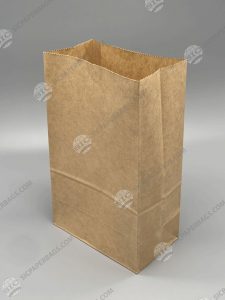Did you know, for every 1 meter of coastline, about 16 plastic bags are thrown away? A plastic bag takes about 100 years to decompose, they are broken into small pieces and float in the ocean.
Meanwhile, a paper bag is biodegradable in about 2-4 months, contributing to slowing climate change. This article will further explain the various benefits of using paper bags
1. Why are paper bags an important part of paper recycling?
According to a survey by global market research company IPSOS for 7 European countries:
- 79% feel more comfortable holding and touching paper products.
- 93% agree that paper is sustainable and should be used more for packaging.
- 86% agree that if they could choose between packaging made from paper or another material, they
- would choose paper packaging.
Besides, most consumers are interested in environmentally friendly packaging:
- 70% support a ban on single-use, non-biodegradable bags in supermarkets.
- 80% agree that only materials that are biodegradable under natural conditions can be called
- biodegradable items (ie can decompose in soil, freshwater or marine environments).
Paper bags
Paper bags are made from wood – a renewable raw material and an ever-evolving resource. Due to the nature of decomposing in nature after 2-5 months, paper bags will not have much impact on marine life.
Besides, paper bags are an important factor in developing brand image. Consumers appreciate paper bags because of the benefits they bring.
Last year, the European Parliament just passed a bill banning single-use plastic items throughout the European Union (EU). If approved by the European Commission and continued to be passed in each EU member state, the law banning single-use plastic items will officially become law in 2021.
2. Paper bags are made from natural materials
Wood is a raw material used in manufacturing and is the main source of paper. This natural resource is renewable and growing.
More than 1/3 of Europe is covered with forests with an area of up to 215 million hectares. This provides enormous natural resources and potential to mitigate climate change.
Forest cover in Europe is increasing by 1.4% per year thanks to reforestation after logging. For every tree cut down, they will replant 2 new trees.
Sustainable forest management includes protecting water sources, developing research into new organisms, protecting biodiversity as well as improving the welfare of forestry workers.
All parts of the tree are used thoroughly when harvested to avoid waste. The trunk is commonly used for lumber and pulpwood. The roots, branches and tops of trees are used for bioenergy needs. Trees are pruned and waste from the sawing process is used to make pulp fiber.
Therefore, paper products such as paper bags have 100% natural ingredients, are renewable and biodegradable.
3. Paper bags store large amounts of CO2
Paper is made from wood – a natural and renewable material. As young trees grow, they absorb carbon dioxide (CO2) from the atmosphere. Furthermore, as a wood product, paper also continues to store carbon throughout its life cycle.
Every 1m3 of wood will absorb 1 ton of CO2 and emit 0.7 tons of O2
Statistics show that the average annual carbon storage of European forests reaches 719 million tons of CO2/year. This amount is equal to the amount of CO2 emissions produced by Germany every year, including the energy industry, manufacturing and construction industries, transport, households, agriculture, and waste. Or equivalent to 209 coal-fired power plants.
CO2 continues to be stored until the tree is cut down, and produced into products such as wood and paper bags.
3. Paper bags reduce climate impact
All industrial activities impact the environment. Life cycle assessment (LCA) can be used as a tool to measure the environmental impact of manufacturing processes. One of those effects is Global Warming Potential (GWP).
The Swedish Environmental Research Institute IVL conducted a study on greenhouse gas emissions between the production of paper and plastic bags. The conclusion proved that paper bags – produced with virgin or recycled fibers – have less impact on global warming (GWP) than Polyurethane bags – produced with LDPE, a thermoplastic made from Ethylene monomer is regenerated or recycled.
4. Paper bags are recyclable and biodegradable
Europe is the world leader in the field of recycled paper:
- Paper recycling rate in Europe is 71.5%
- 59 million tons of paper are recycled each year
- Every second, 2 tons of paper are recycled.
In Europe, on average a paper bag is recycled and reused 3.5 times
Large paper recycling plants operate under Environmental Management Systems (EMS) with high environmental standards.
In cases where heavy products need to be stored, natural Kraft paper bags will stand out because of their durability and high mechanical properties. A paper bag can be reused many times if the quality is good and the design is beautiful.
However, recycling paper also faces some difficulties such as:
- Durable – because the toughness of cellulose fibers will decrease each time it is recycled.
- Quality – certain products such as high-end works of art… can only be created with fresh cellulose fibers.
- Usable – some paper products cannot be recycled, such as books, photos or paper products that biodegrade upon use (toilet paper or cigarette paper).Khoảng 8 triệu tấn chất thải nhựa bị đổ xuống biển mỗi năm, tương ứng 16 túi nhựa trên 1 mét bờ biển. Rác nhựa không bị phân hủy, những vỡ vụn thành các mảnh nhỏ hơn và trộn lẫn vào nguồn thức ăn của sinh vật biển.
If a plastic bag takes over 400 years to decompose, a paper bag can biodegrade within 2 to 5 months – significantly reducing the impact on the environment.
Using paper bags is safer and more environmentally friendly than plastic bags. If you need paper bags domestically or for export, but are concerned about standards, time, quality…, we can make things easier.








